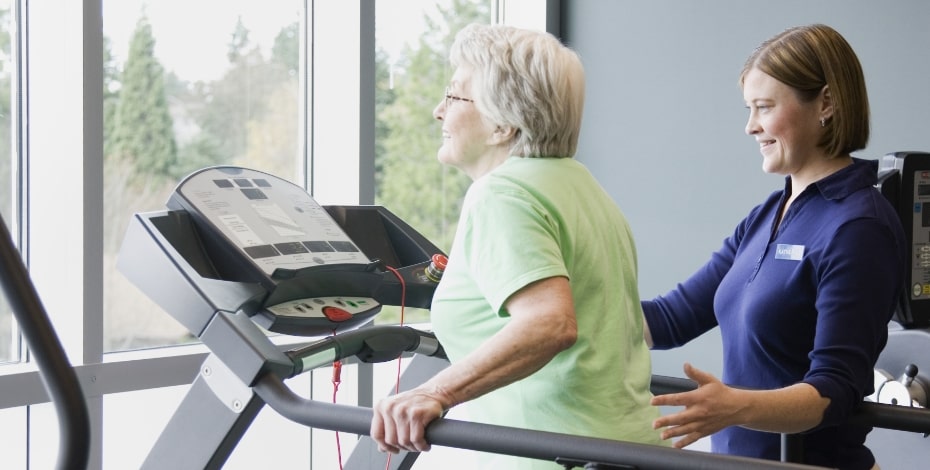
Finding out what patients really want

Jill Nosworthy Seeding Grant recipient Georgina Whish-Wilson talks about the role of exercise in preoperative and postoperative management of people undergoing lung cancer surgery.
Exercise both before and after lung cancer surgery has been shown to be safe and effective, improving symptoms such as shortness of breath, exercise capacity, muscle strength and quality of life.
Despite the evidence, however, most patients are not referred to preoperative or postoperative exercise programs, partly due to the lack of programs available for lung cancer patients.
Georgina Whish-Wilson APAM, a PhD student at the University of Melbourne, is investigating the role of exercise in preoperative and postoperative management of people undergoing lung cancer surgery, with an emphasis on qualitative methods and the lived experience of patients.
She recently published a survey of exercise clinicians, including both physios and exercise physiologists, showing that despite the evidence, patients still aren’t being referred to preoperative and postoperative exercises.
‘We have an abundance of evidence telling us that exercise is safe and effective for lung cancer patients but we also know that these programs aren’t routinely available or offered to this cohort,’ Georgina says.
As a junior physiotherapist working on an acute thoracic surgery ward, Georgina was surprised to see patients recovering from major lung cancer surgeries sent home without referral to exercise rehabilitation, despite having impairments including shortness of breath and a lack of exercise capacity.
‘That was at odds with what I saw in other populations such as people who had had cardiac surgery or those with other chronic respiratory conditions like chronic obstructive pulmonary disease, who were routinely referred to cardiac and pulmonary rehabilitation,’ she says.
‘Coming into my PhD, I wanted to look into why that was and to start building some strategies to change that.’

Georgina Whish-Wilson is investigating the role of exercise in patients undergoing lung cancer surgery.
Georgina was awarded a Physiotherapy Research Foundation Seeding Grant in 2022 to co-design a rehabilitation pathway for lung cancer surgery patients.
The project team includes Associate Professors Catherine Granger and Selina Parry, and Dr Lara Edbrooke, all from the University of Melbourne, as well as Curtin University Associate Professor Vinicius Cavalheri and Daniel Seller, a Wellington, New Zealand-based physiotherapist.
‘As part of building our case for implementing exercise programs, we need to have a good understanding of the wants, needs and attitudes of patients, caregivers, health professionals and policymakers.
‘That’s where the co-design has come in.
‘We’ll be working with these groups to understand what the key design requirements of the exercise programs are as well as the barriers and facilitators experienced by clinicians, patients and caregivers when implementing and participating in these programs.
‘Finally, we’ll come together and co-design some novel solutions to overcome the barriers,’ Georgina says.
The process will include both one-on-one interviews and workshops, initially separated into groups of patients and carers or clinicians and policymakers and then in mixed groups.
‘The one-on-one interviews will form the basis of a broad understanding of what people are currently experiencing pre- and post-surgery.
That will give us a foundation for the workshops, which will unpack current practice, how patients recovered and how clinicians feel about exercise,’ Georgina says.
‘After analysing that data, we will bring all the groups together for a second round of joint workshops, which will look at designing
solutions based on the patient experience and what their needs are.
‘It’s a lot of qualitative work.’
Georgina says the Seeding Grant funding will allow the team to hire a research assistant as well as covering payment to the patients/carers for their participation (clinicians and policymakers will participate with the support of their employers) along with transcription and other costs.
While the outcomes of the study will depend on the priorities expressed by the consumers—the patients and their carers as well as the clinicians looking after them—ultimately, Georgina hopes to generate a strong understanding of what is needed in order to integrate exercise into routine clinical practice.
First, however, she needs to find out what patients actually want.
‘We’re hoping that our findings will mean that more patients will be able to participate in exercise.
‘That could be through designing a whole new exercise program, developing resources to increase referral rates to exercise by improving patient and clinician knowledge about exercise interventions or exploring options for different modes of exercise participation such as telehealth and remote monitoring.
‘The more people who can participate in these exercise programs, the better,’ Georgina says.
‘We know that co-designing interventions can help improve their accessibility, acceptability, feasibility and overall efficacy.
‘Whatever we create as part of this study we’ll be looking to test in a future project.’
>> If you are a health professional or someone with lived experience in lung cancer surgery interested in participating in this project, please email Georgina at g.whishwilson@student.unimelb.edu.au
© Copyright 2025 by Australian Physiotherapy Association. All rights reserved.





